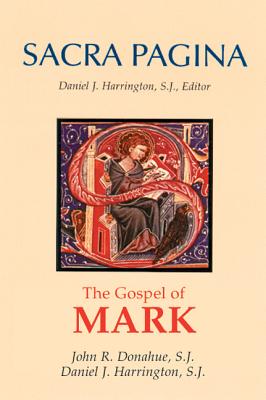Gospel of Mark

Gospel of Mark
In The Gospel of Mark Fathers Donahue and Harrington use an approach that can be expressed by two terms currently used in literary criticism: intratextuality and intertextuality. This intratextual and intertextual reading of Mark's Gospel helps us to appreciate the literary character, its setting in life, and its distinctive approaches to the Old Testament, Jesus, and early Christian theology."Intratextuality" means we read Mark as Mark and by Mark. Such a reading expresses interest in the final form of the Gospel (not its source or literary history) and in its words and images, literary devices, literary forms, structures, characterization, and plot. Reading Mark by Mark gives particular attention to the distinctive vocabulary and themes that run throughout the Gospel and serve to hold it together as a unified literary production."Intertextuality" comprises the relation between texts and a textual tradition, and also referring to contextual materials not usually classified as texts (e.g., archaeological data). "Intertextuality" is used to note the links of the text of Mark's Gospel to other texts (especially the Old Testament) and to the life of the Markan community and of the Christian community today.Chapters are "The Prologue: The Beginning of the Good News (1:1-13)," "Transitional Markan Summary: Proclamation of the Kingdom (1:14-15)," "The Call of the First Disciples (1:16-20)," "A Paradigmatic Day Begins the Ministry of Jesus (1:21-34)," "Highpoints of Jesus' Work in Galilee (1:35-45)," "The Healing of the Paralyzed Man (2:1-12)," "The Call of Levi and Meals with Tax Collectors and Sinners (2:13-17)," "Fasting, Torn Garments, and New Wineskins (2:18-22)," "Plucking Grain of the Sabbath (2:23-28)," "Healing on a Sabbath (3:1-6)," "Transitional Markan Summary: Healing Beside the Sea (3:7-12)," "Choosing the Twelve (3:13-19)," "The Beelzebul Controversy and the True Family of Jesus (3:20-35)," "The Parable of the Sower, Sayings on the Mystery of the Kingdom of God, and the allegory of the Seeds (4:1-20)," "Four Sayings on Revelation and Two Kingdom Parables (4:21-34)," "Jesus 'Power Over the Wind and Waves (4:35-41)," "The Exorcism of the Gerasene Demoniac (5:1-20)," "The Daughter
PRP: 198.07 Lei
Acesta este Prețul Recomandat de Producător. Prețul de vânzare al produsului este afișat mai jos.
158.46Lei
158.46Lei
198.07 LeiLivrare in 2-4 saptamani
Descrierea produsului
In The Gospel of Mark Fathers Donahue and Harrington use an approach that can be expressed by two terms currently used in literary criticism: intratextuality and intertextuality. This intratextual and intertextual reading of Mark's Gospel helps us to appreciate the literary character, its setting in life, and its distinctive approaches to the Old Testament, Jesus, and early Christian theology."Intratextuality" means we read Mark as Mark and by Mark. Such a reading expresses interest in the final form of the Gospel (not its source or literary history) and in its words and images, literary devices, literary forms, structures, characterization, and plot. Reading Mark by Mark gives particular attention to the distinctive vocabulary and themes that run throughout the Gospel and serve to hold it together as a unified literary production."Intertextuality" comprises the relation between texts and a textual tradition, and also referring to contextual materials not usually classified as texts (e.g., archaeological data). "Intertextuality" is used to note the links of the text of Mark's Gospel to other texts (especially the Old Testament) and to the life of the Markan community and of the Christian community today.Chapters are "The Prologue: The Beginning of the Good News (1:1-13)," "Transitional Markan Summary: Proclamation of the Kingdom (1:14-15)," "The Call of the First Disciples (1:16-20)," "A Paradigmatic Day Begins the Ministry of Jesus (1:21-34)," "Highpoints of Jesus' Work in Galilee (1:35-45)," "The Healing of the Paralyzed Man (2:1-12)," "The Call of Levi and Meals with Tax Collectors and Sinners (2:13-17)," "Fasting, Torn Garments, and New Wineskins (2:18-22)," "Plucking Grain of the Sabbath (2:23-28)," "Healing on a Sabbath (3:1-6)," "Transitional Markan Summary: Healing Beside the Sea (3:7-12)," "Choosing the Twelve (3:13-19)," "The Beelzebul Controversy and the True Family of Jesus (3:20-35)," "The Parable of the Sower, Sayings on the Mystery of the Kingdom of God, and the allegory of the Seeds (4:1-20)," "Four Sayings on Revelation and Two Kingdom Parables (4:21-34)," "Jesus 'Power Over the Wind and Waves (4:35-41)," "The Exorcism of the Gerasene Demoniac (5:1-20)," "The Daughter
Detaliile produsului









